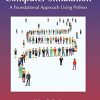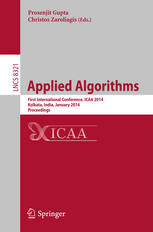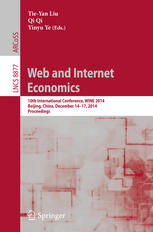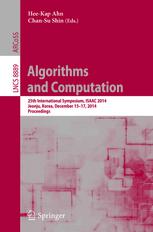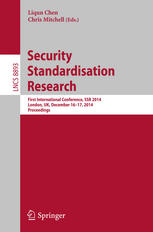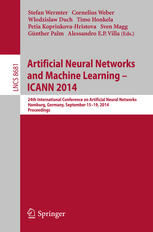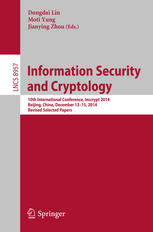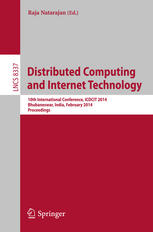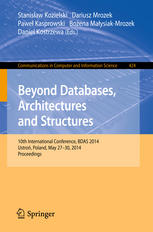Simulated Evolution and Learning 10th International Conference SEAL 2014 Dunedin New Zealand December 15 18 2014 Proceedings 1st Edition by Grant Dick, Will N. Browne, Peter Whigham, Mengjie Zhang, Lam Thu Bui, Hisao Ishibuchi, Yaochu Jin, Xiaodong Li, Yuhui Shi, Pramod Singh, Kay Chen Tan, Ke Tang 3319135632 9783319135632
$50.00 Original price was: $50.00.$25.00Current price is: $25.00.
Simulated Evolution and Learning 10th International Conference SEAL 2014 Dunedin New Zealand December 15 18 2014 Proceedings 1st Edition by Grant Dick, Will N. Browne, Peter Whigham, Mengjie Zhang, Lam Thu Bui, Hisao Ishibuchi, Yaochu Jin, Xiaodong Li, Yuhui Shi, Pramod Singh, Kay Chen Tan, Ke Tang – Ebook PDF Instant Download/DeliveryISBN: 3319135632, 9783319135632
Full download Simulated Evolution and Learning 10th International Conference SEAL 2014 Dunedin New Zealand December 15 18 2014 Proceedings 1st Edition after payment.
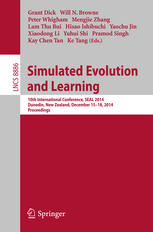
Product details:
ISBN-10 : 3319135632
ISBN-13 : 9783319135632
Author: Grant Dick, Will N. Browne, Peter Whigham, Mengjie Zhang, Lam Thu Bui, Hisao Ishibuchi, Yaochu Jin, Xiaodong Li, Yuhui Shi, Pramod Singh, Kay Chen Tan, Ke Tang
This volume constitutes the proceedings of the 10th International Conference on Simulated Evolution and Learning, SEAL 2012, held in Dunedin, New Zealand, in December 2014. The 42 full papers and 29 short papers presented were carefully reviewed and selected from 109 submissions. The papers are organized in topical sections on evolutionary optimization; evolutionary multi-objective optimization; evolutionary machine learning; theoretical developments; evolutionary feature reduction; evolutionary scheduling and combinatorial optimization; real world applications and evolutionary image analysis.
Simulated Evolution and Learning 10th International Conference SEAL 2014 Dunedin New Zealand December 15 18 2014 Proceedings 1st Table of contents:
Solving Dynamic Optimisation Problem with Variable Dimensions
1 Introduction
2 Dynamic Optimisation Problems
2.1 Change Detection
2.2 Optimisation Approaches for Solving DOPs
2.3 DOPs Test Problems and Generators
3 Dynamic Optimisation Problems with Variable Dimensions
4 Experimental Results and Discussion
4.1 Performance Evaluation
4.2 Behaviour Tracking Evaluation
5 Conclusions and Future Work
References
A Probabilistic Evolutionary Optimization Approach to Compute Quasiparticle Braids
1 Introduction
2 Braids and Anyons
3 Problem Formulation
4 Probabilistic Modeling of Braids
4.1 Boltzmann Distribution
4.2 Statistical Analysis of the Braids Space
5 Estimation of Distribution Algorithms
5.1 Enhancements to the EDAs
6 Experiments
6.1 Experimental Settings
6.2 Best Solutions Found by EDAs
6.3 Behavior of the EDA Variants
6.4 Improvement Over Other Search Methods
7 Conclusions
References
Adaptive System Design by a Simultaneous Evolution of Morphology and Information Processing
1 Introduction
2 Framework for Morphology-Controller Co-evolution
3 Sensor-Actuator-Controller Co-evolution
3.1 Definition of Growth Process
3.2 Experimental Results of Growth Process
4 Conclusions
References
Generating Software Test Data by Particle Swarm Optimization
1 Introduction
2 Particle Swarm Optimization and Test Adequacy Criteria
2.1 Particle Swarm Optimization
2.2 Coverage Criteria
3 The PSO Data Generation Tool (PSODGT)
3.1 Overview of PSODGT
3.2 Condition Table
3.3 Fitness Calculation
3.4 Particle Swarm Optimization for PSODGT
4 Experimental Studies
4.1 Experimental Settings
4.2 Experimental Results and Analysis
5 Conclusion
References
A Steady-State Genetic Algorithm for the Dominating Tree Problem
1 Introduction
2 Related Work
3 SSGA for the DTP
3.1 Encoding
3.2 Initial Solution Generation
3.3 Fitness
3.4 Selection
3.5 Crossover
3.6 Mutation
3.7 Replacement Policy
4 Computational Results
4.1 Problem Instances
4.2 Comparison of SSGA with ABC and ACO Approaches
5 Conclusions
References
Evolution of Developmental Timing for Solving Hierarchically Dependent Deceptive Problems
1 Introduction
2 Related Work
3 Evolutionary Algorithm Evolving Developmental Timing
3.1 Individual
3.2 Individual Development
3.3 Crossover Operator
3.4 Mutation and Selection Operators
4 Hierarchically Dependent Deceptive Problem
5 Simulations
5.1 Algorithms for Comparison
5.2 Settings
5.3 Results and Discussions
6 Concluding Remarks
References
The Introduction of Asymmetry on Traditional 2-Parent Crossover Operators for Crowding and Its Effec
1 Introduction
2 A Brief Review of Crowding Methods
2.1 Crowding Factor Model
2.2 Deterministic Crowding (DC)
2.3 The Extension of Deterministic Crowding
3 Crowding with Asymmetric Crossover (CAX)
4 Empirical Analysis
4.1 Results on the Binary Domains
4.2 Results on the Permutation Domains
4.3 Results on the Real-Value Domains
4.4 CAX for Niching
5 Conclusions
References
The Performance Effects of Interaction Frequency in Parallel Cooperative Coevolution
1 Introduction
2 Experiment Methodology
2.1 Correlation of Subcomponents
2.2 The Domains
2.3 The CCEA Configuration
2.4 Experimental Setup
3 Experimental Studies: Communication Without Cost
3.1 Different Correlation Degrees of Variables
3.2 DifferentMutation Step Sizes
4 Experimental Studies: Communication with Cost
4.1 Different Communication Costs
4.2 DifferentMutation Step Sizes
5 Conclusion and Future Work
References
Customized Selection in Estimation of Distribution Algorithms
1 Introduction
2 Selection and Learning in EDAs
3 Customized Selection
3.1 Customized Boltzmann and Truncation Selections
4 EDAs with Customized Selection
5 HP Functional Model Protein
6 Experiments
6.1 Experiment Settings
6.2 Results for Customized Boltzmann Selection
6.3 Results for Customized Truncation Selection
7 Conclusions and Future Work
References
A Hybrid GP-Tabu Approach to QoS-Aware Data Intensive Web Service Composition
1 Introduction
2 Background
2.1 Atomic Web Service
2.2 Quality of Service
3 Time and Cost Aware Model for Data Intensive Service
4 The Hybrid GP-Tabu Approach
4.1 An Overview of Genetic Programming
4.2 An Overview of Tabu Search
4.3 The Proposed Hybrid Approach
5 Experimental Results and Analysis
5.1 Parameter Settings
5.2 Experimental Results
5.3 Further Analysis
6 Conclusions and Future Work
References
A Modified Screening Estimation of Distribution Algorithm for Large-Scale Continuous Optimization
1 Introduction
2 Screening Estimation of Distribution Algorithms (sEDA)
2.1 Scaling of sEDA
3 Scaling sEDA to High-Dimensional Problems: sEDA-lite
4 Experimental Design
4.1 Artificial Test Problems
4.2 Circle in a Square Problem
4.3 Location Allocation
5 Results
5.1 Artificial Test Problems
5.2 Results for the Circle in a Square (CiaS) Problems
5.3 Results for the 50-Customer Location Allocation Problem
6 Summary
References
Clustering Problems for More Useful Benchmarking of Optimization Algorithms
1 Introduction
2 Clustering
3 Why Use Clustering Problems for Black-Box Optimization Benchmarking?
4 Black-box Optimization Approaches to Clustering
4.1 Difficulties in Comparing with Previous Results
4.2 Results Selected for Comparison
4.3 Clustering Problem Instances
5 Experimental Details
6 Results
6.1 Comparison with Previous Results
7 Summary
References
An Analysis of Differential Evolution Parameters on Rotated Bi-objective Optimization Functions
1 Introduction
2 Background
2.1 Differential Evolution
2.2 Crossover Probability and Separability
2.3 Variance as a Common Currency
3 Experimental Design
3.1 WFG Problems
3.2 Rotations in
3.3 Relative Hypervolume
4 Results and Discussion
4.1 Fixed Rotation Angle
4.2 Fixed F
4.3 Fixed Cr
5 Conclusion
References
Fuzzy Clustering with Fitness Predator Optimizer for Multivariate Data Problems
1 Introduction
2 Related Work
3 Proposal of New Hybrid Fuzzy Clustering Algorithm for Multivariate Data Type Clustering Problems
3.1 The Fitness Predator Optimization with Competitive Predators
3.2 The Proposal of FPO-FCMAlgorithm
4 Experiments
4.1 Experimental Method
4.2 Experimental Results
4.3 Discussion
5 Conclusion
References
Effects of Mutation and Crossover Operators in the Optimization of Traffic Signal Parameters
1 Introduction
2 Problem Formulation
3 Method
3.1 Transport Simulation and Optimization Algorithm
3.2 Evolutionary Algorithm (EA)
4 Simulation Results and Discussion
4.1 Mobility Scenario and MatSim Simulation
4.2 Evolutionary Algorithm Experimental Setup
4.3 Results
5 Conclusions
References
A GP Approach to QoS-Aware Web Service Composition and Selection
1 Introduction
2 Background
2.1 Problem Description
2.2 Objective Function
2.3 Existing GP-Based Composition Approaches
2.4 Existing PSO-Based Composition Approaches
3 Proposed GP Approach
3.1 Fitness Function
4 Design of Experiments
4.1 Two Recent PSO Approaches
4.2 Parameters
5 Results and Analysis
6 Further Investigation
7 Conclusions and Future Work
References
Evolutionary Multi-objective Optimization
A Novel Hybrid Multi-objective Optimization Framework: Rotating the Objective Space
1 Introduction
2 Related Work
2.1 NSGA-II
2.2 MOEA/D
3 Proposed Framework
3.1 Basic Concepts
3.2 Distribution of Group Solution Lines
3.3 Rotating the Objective Space
4 Experimental Results
5 Conclusion
References
PaCcET: An Objective Space Transformation to Iteratively Convexify the Pareto Front
1 Introduction
2 Background
2.1 Multi-objectiveMethods
3 Pareto Concavity Elimination Transformation (PaCcET)
4 Theoretical Properties of PaCcET
5 Experiment: KUR
6 Experiment: DTLZ2
7 Discussion and Conclusion
References
Evolving Hard and Easy Traveling Salesman Problem Instances: A Multi-objective Approach
1 Introduction
2 Traditional Evaluations of Hardness of TSP Instances
2.1 Evolving TSP Instances by Traditional Evaluations of Hardness
2.2 The Conflicts between Two Single Objective Approaches
3 Evolving TSP Instances byMulti-objective Optimization
4 The Influential Features to the Hardness of Instances
5 Validating the Features on TSP Instances
5.1 Validating the Features on Random TSP Instances
5.2 Validating the Features on Sampled TSPLIB Instances
6 Conclusion
References
A Multi-Objective A* Search Based on Non-dominated Sorting
1 Introduction
2 Preliminaries
2.1 A* Definition
2.2 An Extension on Multi-Objective Search
2.3 Crowding Distance
3 NAMOA* and Proposed Method
3.1 NAMOA* Algorithm
3.2 Extension to NSMOA* Algorithm
3.3 An Example
4 Expriments
5 Conclusion
References
Extending AεSεH from Many-objective to Multi-objective Optimization
1 Introduction
2 Two Search Stages in Dominance-Based Multi-objective Evolutionary Algorithms
3 TheAεSεH EMyO
4 Extension of AεSεH for Dominance-Based Search Stage
5 Experimental Setup, Test Problems, and Performance Indicators
6 Simulation Results and Discussion
7 Conclusions
References
User Preferences for Approximation-Guided Multi-objective Evolution
1 Introduction
2 Preliminaries
2.1 Multi-objective Optimization
2.2 User Preferences as Weight Functions in the Objective Space
2.3 Approximation-Guided Evolution
3 Adding User Preferences
4 Comparison with Other Algorithms
5 Conclusions
References
Multi-objective Optimisation, Software Effort Estimation and Linear Models
1 Introduction
2 Data and Models
2.1 Error Measures as Objective Functions
2.2 Linear Models and Multi-objective Optimisation
3 Experiments
4 Results
5 Discussion
6 Conclusion
References
Adaptive Update Range of Solutions in MOEA/D for Multi and Many-Objective Optimization
1 Introduction
2 MOEA/D
2.1 Algorithm
2.3 Problem in the Weighted Sum Based MOEA/D
3 Proposal: Adaptive Update Range of Solutions
3.1 Concept
3.2 Method
3.3 Expected Effects
4 Experimental Setup
4.1 Four Algorithms
4.2 Test Problems and Parameters
4.3 Performance Metric
5 Experimental Results and Discussion
5.1 The Obtained POS on Concave and Convex WFG4s
5.2 The Search Performance on Concave and Convex WFG4s
5.3 The Search Performance on MOKPs
6 Conclusions
References
Evolutionary Machine Learning
Classification of Lumbar Ultrasound Images with Machine Learning
1 Introduction
2 Materials and Methods
2.1 Ultrasound Image Feature of Lumbar Spine
2.2 Feature Extraction
2.3 Multi-Layer Neural Network
2.4 Evolutionary Neural Network
2.5 Materials and Image Acquisition
3 Results and Discussions
3.1 Performance of Neural Network
3.2 Video Processing
4 Conclusion
References
Schemata Bandits for Binary Encoded Combinatorial Optimisation Problems
1 Introduction
2 A Schemata Net Structure
3 A Baseline Schemata Bandits Algorithm
4 A Bilevel Schemata Bandits Algorithm
5 Experimental Results
6 Conclusions
References
Anomaly Detection Using Replicator Neural Networks Trained on Examples of One Class
1 Introduction
1.1 Research Questions
2 Related Work
2.1 Anomaly Detection
2.2 One-Class Learning
2.3 Neural Network for Anomaly Detection
2.4 Replicator Neural Network for Anomaly Detection
3 Learning an Anomaly Detector
3.1 Problem Definition
3.2 Data Preparation
3.3 The Training Algorithm
4 Experiments and Results
4.1 Evaluation Metrics
4.2 Data Sets
4.3 Choosing the Number of Units for the Single Hidden Layer
4.4 Comparison with Other Works
4.5 Discussion
5 Conclusions
References
Walking Motion Learning of Quadrupedal Walking Robot by Profit Sharing That Can Learn Deterministic
1 Introduction
2 Profit Sharing That Can Learn Deterministic Policy for POMDPs Environments
2.1 Action Selection
2.2 Judgment of Perceptual Aliasing
2.3 Learning
2.4 Observation Sequences Which Are Used for Action Selection
3 Walking Motion Learning of Quadrupedal Walking Robot
3.1 Qaudrupedal Walking Robot
3.2 Observations
3.3 Actions
3.4 Episode
3.3
3.5 Reward
4 Experiment Results
4.1 Experment in Environment (1)
4.2 Experment in Environment (2)
4.3 Learning in Envirnonment (2) After Environment (1)
5 Conclusions
References
Genetic Programming for Multiclass Texture Classification Using a Small Number of Instances
1 Introduction
2 The New Method
2.1 Terminal Set
2.2 Function Set
2.3 Fitness Measure
2.4 Fitness Measuring Procedure
2.5 Performance Measuring Procedure
3 Experimental Design
3.1 Data Sets
3.2 Baseline Methods
3.3 Data Sets Preparation
3.4 Parameter Settings and Implementation
3.5 Evaluation
4 Results and Discussions
4.1 Overall Results
4.2 Analysis
5 Conclusions
References
A Stepwise Multi-centroid Classification Learning Algorithm with GPU Implementation
1 Introduction
2 Background
2.1 Particle Swarm Optimisation
2.2 CUDA – GPU Programming
3 Design
3.1 Classifier Representation
3.2 GPU PSO
3.3 Stepwise Centroid Algorithm
3.4 GPU Stepwise Centroid Implementation
4 Experimental Setup
4.1 Experiment Design
4.2 Datasets
4.3 Configuration Settings
5 Results
6 Conclusion
References
Dynamic Selection of Evolutionary Algorithm Operators Based on Online Learning and Fitness Landscape
1 Introduction
2 Background
2.1 Capacitated Arc Routing Problem
2.2 A Case Study: MAENS*
3 Online Fitness Landscape Analysis
4 Online Learning
5 MAENS*-II
6 Experimental Studies
7 Conclusions and Future Work
References
Learning Patterns of States in Time Series by Genetic Programming
1 Introduction
2 Related Work
3 A GP-Based State Detection Methodology
3.1 Window Function
3.2 Temporal-Difference Function
3.3 Multi-channel Function
4 Synthetic State Detection
4.1 Single-Channel Time Series
4.2 Multi-channel Time Series
5 Experiments and Results
5.1 The Experimental Settings for GP
5.2 The Experimental Settings for Non-GP Classifiers
5.3 Experimental Results on Synthetic Tasks
5.4 Experimental Results on a Real-world Task
6 Conclusions
References
Reusing Learned Functionality to Address Complex Boolean Functions
1 Introduction
2 Background
3 TheMethod
4 Results
4.1 Experimental Setup
4.2 Boolean Problems
5 Discussion
6 Conclusions
7 Future Work
References
Analysis of Online Signature Based Learning Classifier Systems for Noisy Environments: A Feedback Co
1 Introduction
2 Online Signature Extraction System
3 Analysis of Signature Learning Bounds
4 Signature Extraction in Noisy Environments
4.1 Experiments with Noisy Checkerboard
5 Conclusions
References
Multi-objective Multiagent Credit Assignment Through Difference Rewards in Reinforcement Learning
1 Introduction
2 Background
3 Multiobjective Bar Problem (MOBP)
4 Collective Transport Domain
5 Conclusion
References
Theoretical Developments
On the Impact of Utility Functions in Interactive Evolutionary Multi-objective Optimization
1 Introduction
2 Interactive Multi-objective Optimization
2.1 Decision Makers
3 Deteriorative Cycles
3.1 Linear Decision Maker and Deteriorative Cycles
4 Linear Decision Maker and Linear Objective Functions
4.1 Linear Objective Functions
4.2 The Knapsack Problem
5 Chebyshev Utility Function and the Knapsack Problem
Theorem 5.
6 The Multi-Objective Leading Ones Problem
7 Conclusions
References
Beyond the Edge of Feasibility: Analysis of Bottlenecks
1 Introduction
2 Background
3 Limitations of the Existing Bottleneck Definition
4 A New Model for Bottleneck
5 An Evolutionary Algorithm for BCOP
6 Conclusions and Directions
References
Adaptive Risk Aversion in Social Dilemmas
1 Introduction
2 Background and Related Work
2.1 Public Goods Game Using Continuous Investment Strategies
2.2 Mobility in Social Dilemma Models
3 Model
3.1 Investment Strategy and Payoff
3.2 Migration: Inter-group Mobility
4 Simulation Experiments
4.1 Evolutionary Trajectory of
4.2 Evolutionary Trajectory of
4.3 A Closer Look at Mobility
5 Discussion and Conclusions
References
Fitness Landscape Analysis of Circles in a Square Packing Problems
1 Introduction
2 Fitness Landscape Analysis Techniques
3 Circle Packing Problems
4 Experimental Results
4.1 Length Scale Analysis
4.2 Dispersion
4.3 Fitness Distance Correlation
4.4 Information Content, Partial Information Content and Information Stability
5 Conclusions
References
Local Landscape Patterns for Fitness Landscape Analysis
1 Introduction
2 Landscape Feature Using Local Landscape Patterns
3 Experiments and Results
3.1 Basic Properties of LLP
3.2 Comparison with Conventional Landscape Features
3.3 Fitness Landscape Analysis of BBOB 2013 Functions
4 Conclusion and Future Work
References
Why Advanced Population Initialization Techniques Perform Poorly in High Dimension?
1 Introduction
2 Background
2.1 Stochastic Initial Populations
2.2 Deterministic Initial Populations
2.3 Quality Measures
3 Experiments
3.1 Experiments Setup
3.2 Results and Discussions
4 Conclusions
References
Bloat and Generalisation in Symbolic Regression
1 Introduction
2 Generalisation in Symbolic Regression
2.1 Bloat Control and Generalisation
3 Experimental Framework
3.1 Spatial-Structure with Elitism
4 Results
4.1 Performance of GP Relative to Traditional Methods
5 Conclusion
References
Evolutionary Feature Reduction
Improved PSO for Feature Selection on High-Dimensional Datasets
1 Introduction
1.1 Goals
2 Background
2.1 Particle Swarm Optimisation (PSO)
2.2 RelatedWorks on Feature Selection
3 Proposed Approach
3.1 Overall Algorithm
3.2 Reset
3.3 Local Search on
4 Experimental Design
5 Results and Discussions
5.1 The Standard PSO
5.2 Effect of Reset
5.3 Effect of Local Search on
5.4 Combination of Local Search and Reset
5.5 Computational Time
5.6 Further Discussions
6 Conclusions and Future Work
References
Multi-objective Feature Selection in Classification: A Differential Evolution Approach
1 Introduction
1.1 Goals
2 Background
2.1 Differential Evolution (DE)
2.2 RelatedWork on Feature Selection
3 Proposed Approach
3.1 Single Objective Algorithm 1: DEFS
3.2 Single Objective Algorithm 2: DEFS2
3.3 Multi-objective Algorithm: DEMOFS
4 Design of Experiments
4.1 Benchmark Techniques
5 Results and Discussions
5.1 Results of DEFS and DEFS2
5.2 Results of DEMOFS
5.3 Comparisons between DEFS, DEFS2 and DEMOFS
5.4 Comparisons with Traditional Methods
6 Conclusions and Future Work
References
A Multi-objective Optimization Method for Product Feature Fatigue Problem
1 Introduction
2 Multi-objective Optimization Model for Feature Fatigue Problem
2.1 General Form for Feature Fatigue Multi-objective Optimization Model
2.2 The Objective Functions Considering the Impact of Feature Difference and Feature Number
3 Multi-objective Optimization Based on NSGA-II
4 Pareto Optimization Based on Piecewise Linear Membership
5 Case Study
5.1 Case Description
5.2 Problem Solving
5.3 Discussion
6 Conclusions
People also search for Simulated Evolution and Learning 10th International Conference SEAL 2014 Dunedin New Zealand December 15 18 2014 Proceedings 1st:
what is simulated learning
simulated learning meaning
evolve and evolution difference
evolve and adapt meaning
evolution vs evolving
Tags: Simulated Evolution, Learning, International Conference, New Zealand, Proceedings, Grant Dick, Will Browne, Peter Whigham, Mengjie Zhang, Lam Thu Bui, Hisao Ishibuchi, Yaochu Jin, Xiaodong Li, Yuhui Shi, Pramod Singh, Kay Chen Tan, Ke Tang
You may also like…
Computers - Computer Science
Computers - Networking
Computers - Programming
Computers - Computer Science
Computers - Computer Science
Computers - Computer Science
Computers - Networking



